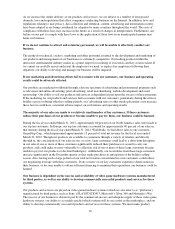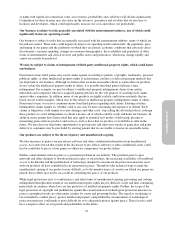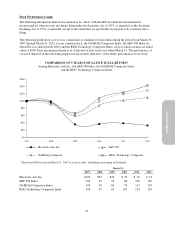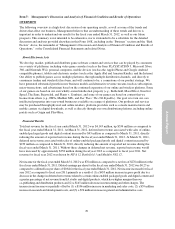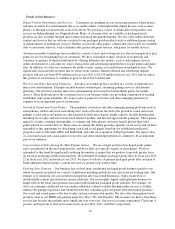Electronic Arts 2012 Annual Report Download - page 106
Download and view the complete annual report
Please find page 106 of the 2012 Electronic Arts annual report below. You can navigate through the pages in the report by either clicking on the pages listed below, or by using the keyword search tool below to find specific information within the annual report.shares of common stock underlying the Notes. We also entered into separate, privately-negotiated warrant
transactions with the certain counterparties whereby we sold to independent third parties warrants (the
“Warrants”) with the Option Counterparties relating to the same number of shares of our common stock, subject
to customary anti-dilution adjustments.
In connection with establishing their hedge position with respect to the Convertible Note Hedge and the
Warrants, the Option Counterparties and/or their affiliates:
• may have entered into various cash-settled over-the-counter derivative transactions with respect to our
common stock and/or purchased shares of our common stock concurrently with, or shortly following, the
pricing of the Notes; and
• may unwind any such cash-settled over-the-counter derivative transactions and purchase shares of our
common stock in open market transactions, including any observation period related to the conversion of
the Notes.
The effect, if any, of these activities, including the direction or magnitude, on the market price of our common
stock will depend on a variety of factors, including market conditions, and cannot be ascertained at this time.
Any of these activities could, however, adversely affect the market price of our common stock and the trading
price of the Notes.
In addition, the Option Counterparties are financial institutions, and we will be subject to the risk that one or
more of the Option Counterparties might default under the Convertible Note Hedge. Our exposure to the credit
risk of the Option Counterparties will not be secured by any collateral. If any of the Option Counterparties
becomes subject to insolvency proceedings, we will become an unsecured creditor in those proceedings with a
claim equal to our exposure at the time under the Convertible Note Hedge with such option counterparty. Our
exposure will depend on many factors but, generally, the increase in our exposure will be correlated to the
increase in the market price and in the volatility of our common stock.
Changes in our tax rates or exposure to additional tax liabilities could adversely affect our earnings and
financial condition.
We are subject to income taxes in the United States and in various foreign jurisdictions. Significant judgment is
required in determining our worldwide provision for income taxes, and in the ordinary course of our business,
there are many transactions and calculations where the ultimate tax determination is uncertain.
We are also required to estimate what our tax obligations will be in the future. Although we believe our tax
estimates are reasonable, the estimation process and applicable laws are inherently uncertain, and our estimates
are not binding on tax authorities. The tax laws’ treatment of software and Internet-based transactions is
particularly uncertain and in some cases currently applicable tax laws are ill-suited to address these kinds of
transactions. Apart from an adverse resolution of these uncertainties, our effective tax rate also could be
adversely affected by our profit levels, by changes in our business or changes in our structure resulting from the
reorganization of our business and operating structure, changes in the mix of earnings in countries with differing
statutory tax rates, changes in the elections we make, changes in applicable tax laws (in the United States or
foreign jurisdictions), or changes in the valuation allowance for deferred tax assets, as well as other factors.
Beginning in fiscal year 2009, we recorded a valuation allowance against most of our U.S. deferred tax assets.
We expect to provide a valuation allowance on future U.S. tax benefits until we can sustain a level of
profitability or until other significant positive evidence arises that suggest that these benefits are more likely than
not to be realized. Further, our tax determinations are regularly subject to audit by tax authorities and
developments in those audits could adversely affect our income tax provision. Should our ultimate tax liability
exceed our estimates, our income tax provision and net income or loss could be materially affected.
We incur certain tax expenses that do not decline proportionately with declines in our consolidated pre-tax
income or loss. As a result, in absolute dollar terms, our tax expense will have a greater influence on our
effective tax rate at lower levels of pre-tax income or loss than at higher levels. In addition, at lower levels of
pre-tax income or loss, our effective tax rate will be more volatile.
22






